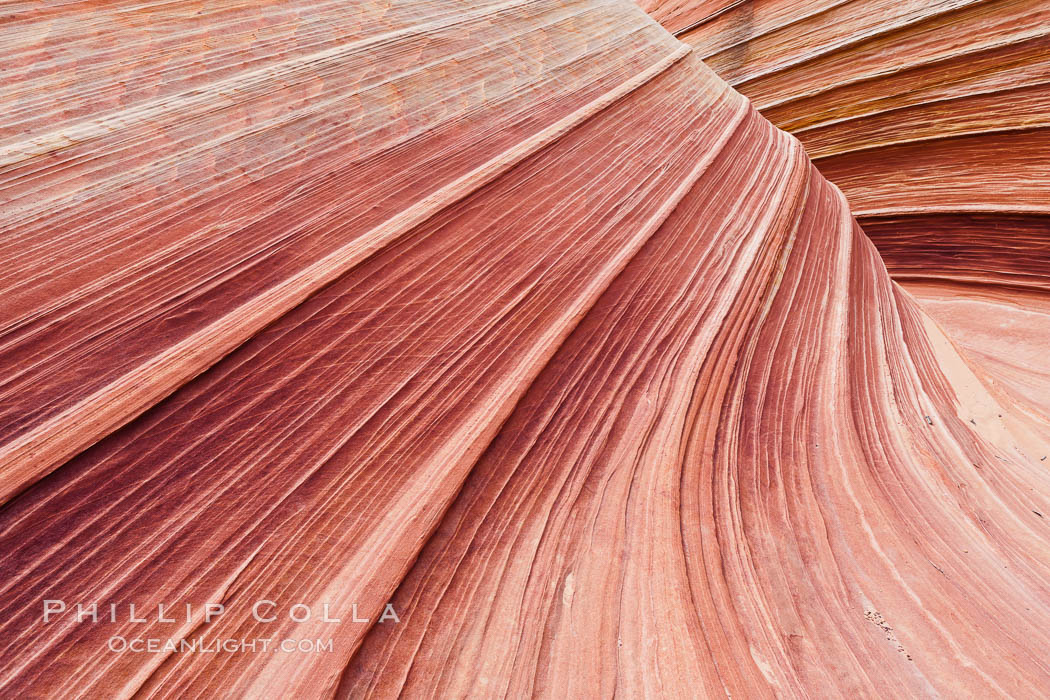Once I reached the Wave and got over my initial wonder, I began to wander around and explore the whole area. For a photographer it is hard not to start taking photos as soon as one sets foot inside the Wave. Just like everyone else, I immediately shot some pics, but then set the camera back in the bag and left the main bowl of the Wave behind for a while. While the Heart of the Wave, as the main bowl is sometimes called, is the natural focal point for first time visitors, the surrounding brain rocks, alcoves, layered and cross-hatched sandstone are all curious and mesmerizing in their own right. After a few hours exploring I found that what caught my interest the most were the details within the heart of the Wave itself. The more prominant striations seem like ribs on the inside of some great geologic abdomen, holding the skin taut. It is amazing to think of the years of Jurassic history represented by the countless layers seen so beautifully in cross-section in the Wave.
The Wave, an area of fantastic eroded sandstone featuring beautiful swirls, wild colors, countless striations, and bizarre shapes set amidst the dramatic surrounding North Coyote Buttes of Arizona and Utah. The sandstone formations of the North Coyote Buttes, including the Wave, date from the Jurassic period. Managed by the Bureau of Land Management, the Wave is located in the Paria Canyon-Vermilion Cliffs Wilderness and is accessible on foot by permit only.
Image ID: 20607
Location: North Coyote Buttes, Paria Canyon-Vermilion Cliffs Wilderness, Arizona, USA
The wind did strengthen during the day, but it could hardly be felt within the heart of the Wave itself. The bowl-shaped Heart of the Wave and the surrounding cones and bluffs made it nearly dead-calm within the bowl. Hiking up and out of the bowl to explore the shoulders of the ridge and up towards the alcove and notch high above, I encountered some stiff wind that grew stronger as the day went on.
There were some other visitors at the Wave, of course. Interestingly, at least a third of the visitors the day I was there were German: three independent couples all making multi-week trips through the American Southwest (e.g., Zion, Bryce, Arches, Canyonlands, Grand Canyon, Monument Valley, Bisti Badlands, Page, etc.) One German fellow, who had been to the Wave twice previously, kindly pointed me to the “Second Wave“, which I hoped to photograph at sunset. He also informed me that the Wave has become particularly popular with Germans after it was featured in a movie. Most of the other hikers arrived some time after me and left earlier in the day, so it was not hard for me to find solitude during the day. In fact, everyone else had left by about 3pm, so I had the entire Wave area to myself from that point on. It was perfectly quiet with the exception of wind gusts sounding on the ridge above and the occasional bird. I stayed until sunset and hiked out in the dark. Once I left the becalmed heart of the Wave and hit the trail, I was met head-on with a stiff, sand-filled wind. In spite of the dark I kept my sunglasses on, hitched up my jacket and jammed back to the car, trying to ignore the constant trickle of sand slipping between my neck and collar. Once in the car I blazed back through Kanab, Hurricane, St. George then on to Vegas arriving after midnight. A great day, but killer tiring.
More in the coming days.




